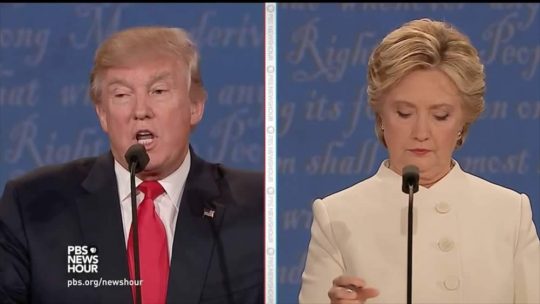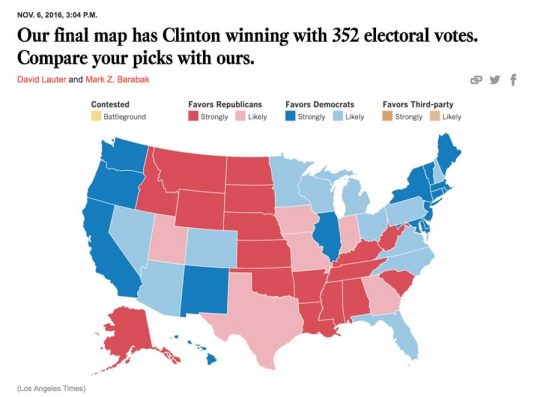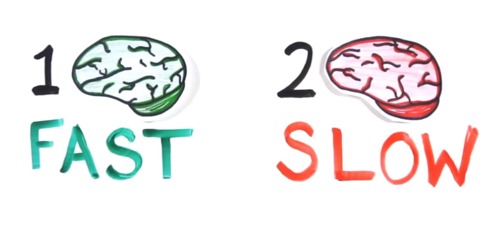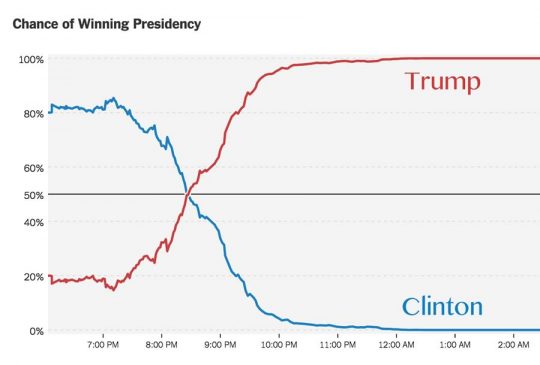Trump Surprise: Four Neuromarketing Takeaways from the 2016 Election

A few hours ago, the U.S. Presidential election concluded. The result was the election of Donald Trump, an outcome that contradicted the results of almost every poll and expert prediction. Considering the amount of time and money that went into this predictive market research, the inability to come close in predicting the outcome can only qualify as an epic fail.
Here’s what the LA Times predicted just 48 hours before the election:

Ironically, the Daybreak Tracking Poll conducted by the LA Times and the University of Southern California was the only significant poll to show Trump leading Clinton in the days before the election. It used a different methodology, but apparently wasn’t considered trustworthy enough to alter the prediction of a Clinton landslide.
Here are a few thoughts on the research process, on Trump’s surge, and how you can apply what we learned to your business..
Trump Surprise: Four #Neuromarketing Takeaways from the 2016 Election Share on X
Why were conventional polling techniques so wrong?
Advocates of neuromarketing have pointed out for years that conducting market research by asking people questions is seriously flawed. People can’t (or won’t) predict future behavior with accuracy, even with simple binary choices. They have even more difficulty with “why” questions that seek to understand their behavior and choices.
The challenge of predicting the outcome of the U.S. election for president is made even more difficult by several factors. For one, a national survey doesn’t mean much when the candidates are relatively close. At this point, it seems likely that Hillary Clinton will finish with a majority of the popular vote, albeit by a lower margin than most pollsters predicted. One really has to predict outcomes on a state by state basis, greatly increasing complexity and sample sizes.
Political pollsters are faced with many challenges – sampling the right people to represent the entire population is a big one. Not all segments of the population are equally accessible by landline telephones, and polling by other means is also problematic.
Plus, the researchers trying to predict election outcomes are really dealing with predicting not one but two behaviors, showing up to vote and choosing a candidate.
I don’t want to engage in a long defense of traditional survey methods, as I find them suspect for most purposes. But, the final point I’d make is that in this kind of election margins of victory can be very small. A percentage difference that would look like a rounding error in commercial market research can determine the outcome of a state and, indeed, the entire election. Commercial market research has no need for the sort of precision where 49% is an entirely different outcome than 51%.
Business Takeaway: Human behavior is hard to predict, particularly by asking small numbers of people what they will do in the future. Fortunately, consumer research doesn’t demand the precision needed to predict the outcome of an extremely close election.
Why Did Trump’s Message Resonate With Voters?
Books will be written about this topic, but there’s little doubt that Trump effectively tapped into the emotions of many voters. He surfaced fear and anxiety about their economic future. He tapped into human tribalism by focusing on differences between people and an emphasis on immigration as a threat.

Above all, it’s my opinion that Trump’s messaging was simple, emotional, and targeted at voters’ System 1 thinking. As Nobel winner Daniel Kahneman explained in his book Thinking, Fast and Slow, System 1 thinking is fast, intuitive, emotional, and energy efficient. System 2 is slow, logical, rational, and hard work for our brains. Humans will avoid System 2 thinking whenever they can, and Trump’s messaging took advantage of that.
For example, look at the debate about immigration.
Hillary Clinton. Her immigration policy has nine bullet points. Here’s the first one:
Introduce comprehensive immigration reform. Hillary will introduce comprehensive immigration reform with a pathway to full and equal citizenship within her first 100 days in office. It will treat every person with dignity, fix the family visa backlog, uphold the rule of law, protect our borders and national security, and bring millions of hardworking people into the formal economy.
Subsequent bullets include, “End the three- and 10-year bars,” “Defend President Obama’s executive actions—known as DACA and DAPA—against partisan attacks,” and more. If I listed them all, you (and everyone else) would likely tune out and leave. This message is highly complex and has to be decoded by System 2, which requires more focus and effort than most people will give.
Donald Trump. His message isn’t nuanced.
I’ll build a wall.
Clearly, immigration reform is a complex issue that requires deep analysis and nuanced policy. But, voters aren’t going to listen to that. They will tune out and remember nothing. I think a word association test would show this. Ask a thousand voters to think of a word associated with “Trump” and “immigration,” and the vast majority would say “wall.” The same question with Clinton’s name would produce a much more muddled result, with the negatively-charged “amnesty” featuring prominently.

Across just about all topics, Trump kept his messaging simple and emotional. “Make America great again!” is perhaps the best example. He rarely dug into policy specifics that would bore or confuse voters. His talking points were aimed at System 1 thinking, and the decision to vote for Trump was likely a System 1 decision for many voters.
Donald Trump's messaging appealed to the voters' System 1 thinking. pic.twitter.com/Ff5Kzt8G0f #Neuromarketing Share on XBusiness Takeaway: All too often, marketers have a tendency to focus on product features, specifications, prices, and other factual details. To resonate with customers, the appeal should be simple and, if possible, focused on a pain point. Make the boring details available for those who need them, but keep them out of view for most customers.
Would Neuromarketing Have Helped Predict the Outcome?
Neuromarketing techniques do have the ability to get beneath what consumers say and can sometimes predict behavior better than traditional survey methods. In the case of the flawed polls, though, I think the failure may have been more a matter of sampling and statistics. But, it is possible that some non-conscious techniques might have spotted ambivalence among some voters who favored Clinton. The scale needed to add to the accuracy of state-by-state predictions would be daunting, particularly if one wanted to do the testing within a couple of days of the election.
Certainly, some selective neuromarketing studies could have been used to tweak the larger-scale traditional poll numbers, although such tweaking would be viewed as subjective.
By the next election, though, who knows? Millions of voters will be wearing biometric sensors, otherwise known as smart watches and Fitbits. Even more millions will have smartphone and other cameras pointed at their faces, making them potential subjects for facial coding analysis. If researchers can find a way to turn these millions of voters into willing subjects, we might actually get accurate predictions.
Putting Big Data information into the mix would allow highly granular segmentation of data. Slicing results by location, ethnicity, income, and many other factors known about each consumer would yield a far better understanding of what the results mean.
And, flipping it around, this could also lead to highly targeted political marketing. Conventional wisdom is to focus on independents and undecided voters, rather generic catgories. Neuromarketing data could identify voters who are on the fence, show which way they are leaning, and suggest the most effective appeal to convert them.
Business Takeaway: Prepare for a world where neuromarketing studies aren’t a few dozen subjects in a lab but can be scaled to massive levels at reasonable cost. Not far behind will be neuromarketing-based personalization of messages.
One Prediction Tool That Worked
I watched the results of the 2016 election into the early hours of the morning. It wasn’t until after 2AM New York time that major press entities called the race for Trump. A fascinating tool from the NYTimes.com, though, made it clear that Trump was headed for victory many hours earlier.

To be clear, the major news networks won’t declare a winner unless is 99.9+ percent certain they are right. Candidates concede or claim victory based on these declarations, and the consequences of making the wrong call are enormous. So, of necessity, they are conservative.
The NYTimes.com tool, though, offered real-time projections based on the newest vote counts. As early as 7:30 PM, their chart showed a shift in momentum. By 8:30 PM, when a small fraction of the total votes were counted, they showed that the probablility of Clinton winning had slipped from a high of 85% just 90 minutes before to a 50-50 dead heat with Trump. Another hour, and Trump’s probability had surged to 90%. By 10PM, the probability of a Trump win was closing in on 95%. While there were a few quick wiggles in the early stages, as more votes came in the predicted percent grew ever more stable.
The clever folks at NYTimes.com also provided statistical error bars for their state projections. When few votes were counted, the bars were wide and, when they overlapped the vertical axis, showed the losing candidate still had a chance. As more votes were counted, these bars grew smaller, eventually turning into just a solid dot.
Here’s a late example when almost everything had been called – the display, which showed only the most hotly contested states, was a lot more interesting earlier in the evening.

As in any really effective visualization tool, they also provided a nice summary dashboard that, like the other data, updated in real time:

This was a very nicely presented view of the probable election outcome, and gave viewers useful information hours earlier than the major networks.
Business Takeaway: Use the information tool that combines speed with accuracy adequate for your purposes. Stock, currency, and commodity traders used early but reliable information like this to make “Trump wins” trades hours before the networks were close to calling the race.
Don't wait for more precise data when what you have is good enough. pic.twitter.com/5BPsa9p3v8 #Neuromarketing Share on XWhat’s your take on the U.S. election, the failure of the pollsters, why Trump won, etc.? Leave a comment with your thoughts!

Great summary of what went down, I found myself staring at the NYT tools for most of the night, they were fascinating.
I agree, Brian – great data visualization. Simple, but contained a lot of information.
Thanks Roger! Such a fantastic insight. 🙂
Thanks, Omid!
Thank you Roger.
Nice article!
Or how about intimidation: Trump voters didn’t want to deal with being harangued and so they simply refuse to self-identify.
Nick de Peyster
Very possible, Nick. One of the classic problems with market research is that people don’t always tell the truth. This is particularly true with questions about things like alcohol, drugs, medical conditions… and politics. They might be embarrassed, even if the survey is anonymous, or simply don’t want other people to know.
I guess it depends on where you live. In Ohio and Kentucky, it was dangerous to identify as a Hillary supporter and continues to be dangerous to come out as a lesbian married to a woman.
Darla, on a lot of questions no matter how you answer you may know some people will be critical. So, many people answer by making something up or by offering the answer they feel the person asking will find most acceptable. The more charged the topic, the more problems traditional surveys have with accuracy.
I’m non-American and I didn’t follow the election night coverage, but this article offers great marketing insight. Thank you for introducing me to the concept of System I/II thinking. I’m glad I clicked that link in Rohit Bhargava’s email.
Roger, Having been involved in politics from 1985-2005, and studying and applying neuromarketing since then I find your analysis brilliant! Darryl Howard
Thanks, Darryl!
Actually the polls were off by a couple of points. Most of the national polls had converged on a 3.5% national margin in favor of Clinton, and as of right now, it looks as though Clinton is going to “win” the national popular vote by about 1.75%. Unfortunately for Clinton, we don’t elect the President by direct national popular vote and her voters were not optimally distributed…running up the score in Illinois or California doesn’t matter. We won’t know for sure until next week, but it looks like a shift of fewer than 70,000 votes across three states would have changed the outcome. Contrary to the national I think the real story here is the drop in turnout, Both Clinton and Trump received fewer votes than Obama, McCain and Romney.
It would be interesting to see if a cost-effective means of measuring a large sample of people emotionally could be devised. About 20 years ago, there was a thriller novel written by the science fiction writer Neal Stephenson under a pen name which speculated about a future device that someone would wear like a wristwatch but which could collect biometric data automatically. Members of the panel would watch political speeches on TV and the devices would send the data to a central location and their reaction was used to craft political messages almost in real time. I imagine we’re far away from having similar capacity in real life!
I agree, Bill. Trying to predict electoral outcomes by state is a different scale of research. And, when you are talking about differences of a percent or two the margin of error will probably include both outcomes.
>>a future device that someone would wear like a wristwatch but which could collect biometric data automatically
Like an Apple watch or Fitbit? 🙂
Trump is proof of the power of the red tie.
Good point, Eric, that look would be a bit tougher for Hillary to pull off… Though the “red dress” effect could be even more potent. 😉
Hi Roger Dooley
First off I want to thank you for pointing me into the direction of neuromarketing and for your consistent effort in offering highly educational content.
I am a marketing student in Canada, and as I was following the American election some of these neuromarketing concepts were just screaming at me to the point where I was in the process of writing to you about them! So, needless to say, I am very glad that you wrote an article covering the main neuromarketing takeaways.
A couple of things I want to emphasize is that similarly to Barack Obama’s “It’s time for change”, Trump’s “Let’s make America great again” may have played a big role in his influence. Something that the Hilary Clinton campaign lacked, in my opinion. Also, to highlight what you said regarding the incapability to predict our behaviors, take the women vote for example. It was rationally perceived that there would be a large decrease in women support for Trump considering all of the controversy involving sexist remarks and allegations of sexual conduct with women. But from my understanding, this was not the case. In fact, it didn’t really have much of an effect on republican women.
I think we have seen similar results in neuromarketing studies like how you would rationally expect gross pictures displaying the harmful effects of smoking to deter smokers, but it also has no effect.
It was a terrific read, thank you, Roger.
Thanks, Matthew. Good point about Obama’s emphasis on change. “Change” is simple, it’s non-specific… just the implication of something better than now.
Well said!
Great analysis as always. Thanks Roger. I believe this election demonstrates the power of MESSAGE over every other component of marketing. The right message will beat a larger budget, a more creative delivery, a celebrity endorsement and more. The exit polls showed how on-target Trump’s message was. The majority of folks who voted for Clinton felt things were better than they were 50 years ago. The majority of those who voted for Trump felt they were worse. Both groups believed the trends would continue. If people believe things are worse now than 50 years ago — and are getting even worse — of course they want change. This is not to say Trump “picked up” on that or commissioned research to get that info. It’s what HE felt. He just assumed everyone else felt the same way. And he was right — at least about the 50% of US voters who supported him.
You are probably right, George. And people who are dissatisfied with the status quo are probably a bit more likely to vote than those who think things are heading in the right direction.
Fabulous analysis as usual Roger – thank you. I for one was not totally surprised by the outcome as I had a sneaky suspicion that the syntax and vocabulary of both party’s rhetoric would have a profound effect on voters. Trump’s messages were simple, easy to understand and he used words of very few syllables. (And, as you rightly point out he appealed to emotion.) Clinton, on the other hand sent out a more ‘intellectual’ message. In my opinion, it might not have been easy to grasp her meaning for the entire population, particularly for those don’t have higher levels of education or for whom English might not be their first language. I’m surprised that no one on her team caught on to this. I’m not siding with anyone in this post and these are just my observations. – but as a Brit (who lives in the USA half the year – I will say a huge ‘thank you’ to America for taking the focus off Brexit 😉 Cheers and toodle pip!
This vote was very different from Brexit, but a few things were similar. Trump’s messaging about national pride, fear of being overrun by immigrants, emphasis on social identity, etc. weren’t unlike pitches for Brexit. Simple, emotional messages will trump (sorry!) facts and figures every time.
Roger – just an aside – when commenting – the words in your comments section is greyed out and it is a bit difficult to see what one is typing – so excuse the errors in my post above, I’m not the world’s best typist at the best of times. I would correct it but there doesn’t seem to be an edit option.
All the best
Jayney
“Yuge” thanks for the info about commenting, Jayney, I’ll check that out.
Thanks bigly style Roger ?
Really good analysis! It’s been a long time since a huge article appealed to my System 1 brain. 😉 Very well written.
Excellent breakthrough of the events, indeed!
Just yesterday at our yearly “Neuroscience in politics” event we met similar conclusions with Trump’s campaign and System 1.
You might like to take a look to the article about the study we did a year ago:
http://seele.education/blog/why-did-surveys-fail-to-reflect-peoples-choice-a-dive-into-brainwaves-has-some-insight-we-are-doing-the-wrong-questions/
Best regards,
C.M.
Great insight. I think it validates the marketing discipline of “Don’t tell me how great you/your product is, tell me how you’re going to solve my problem.” Considering where Trump was starting from, simple language was the best, if not only way, to break through that barrier.
Thank you Roger for this excellent article. I believe that the issues regarding the use of the particular server e-mails from hillary may have enabled the fear in relation to national security issues.
When Bill Clinton was president, at first denied the case of Monica Lewinsky, even admitting the lie and apologizing. I believe that the voter may have remembered this lie when Clinton said there was nothing important in e-mails that have been deleted. Although consciously believed in Hillary unconsciously sounded a warning that it had already occurred before, and was much closer to her, it represented an old way of doing politics.
Roger: Your article stimulated me to write a book chapter from which I share this abstract. Thanks.
The recent presidential election in the U.S. has uncovered fatal flaws in accuracy of statistical polling models. Correcting the problems will require the application of cognitive principles of drama and Identification to polling models. Observers in the field of neuro-marketing have begun to discern the cognitive dynamics from the angle of advertising. These same dynamics have been employed in the video game industry to improve game stories and make them more immersive. Ironically, due to its over-emphasis on profit, the game industry has only recently begun to emphasize quality narrative architecture; as it turns out quality narratives are very profitable. Neuro-marketing is the latest chapter in the evolution of profit-motivated psychological advertising. It draws its incipient methodologies from the plethora of recent cognitive research that is based on interrogation of unconscious dynamics and processes of the nervous system. Because of its applications in the fields of artificial intelligence (AI) and robotics, knowledge and use of these neuro-dynamics is advancing at an incredible rate. Even in their infancy, applying these advances to marketing manipulation and political propaganda has the potential to influence society in matters no less important than presidential elections. Beyond marketing and polling, these two dynamics of drama and identification have been addressed in theoretical depth relative to the healing potentials of Pychecology video games (PEG) that incorporate and emphasize Jungian psychology, narrative architecture, and holonomics as a model for programming mediated drama to foster coherent states for healing collective psychosis.
Stephen Schafer
dagazschafer@comcast.net
researchgate
I am sorry Stephen but what did you say after, Roger: ?
He has to be tapping into something subconsciously to most people. I can see right through him, but for some reason people are buying into it.
In my view, Fear, with a capital “F”, tapped into a tribal nerve. People buy relief, not prevention. Trump was an aspirin for the last gasp of white, male dominance in America. The white, male demographic is so frustrated with minorities gaining in numbers and women rising in the ranks, they lashed out in droves and voted. Immigration only became the tag to hitch their pain.
That may explain some votes, Michelle. I think a bigger fear is that “good jobs” for less educated people are very scarce. This is particularly true for traditionally male jobs like heavy manufacturing and construction, many of which allowed a solid middle class lifestyle a couple of decades ago. Except for some infrastructure spending, I doubt that Trump (or anyone) can do much to bring these back – he’s got to contend with not just globalization, but the even more powerful forces of automation and AI. Immigration gets blamed for the loss of jobs, but IMO it’s a minor factor when the jobs people imagine they want (auto plants, steel mills, etc.) aren’t going to come back in big numbers.
Very nice article with insightful summary of reasons behind Trump’s success. I was also watching the NYTimes.com tool until late night hours and found it fascinating. In addition to your points, I would add one more – Trump used Blue Ocean Strategy methodology (consciously or not) to go after “non customers” and “marginal customers”, in other words people who not always vote or are swing voters. This demographics included people living in more rural and small town America, blue collar, “rust belt” voters, driven by nostalgia and fear of change. Also, these voters suffered more from the recent crisis, benefited less from Obama-care, and lost jobs due to trade treaties. Simple, emotional message resonated really well with them. Plus, they dislike political correctness and political elites.
Excelente visión de las cosas y manejo de las ventas
Kasia –I felt it’s more of a “disruptive innovation” strategy: to start as an outsider, lower quality substitute. Along with his neuromarketing skills (REMEMBER he was a Wharton graduate!!), then ramp up in to the mainstream market and take over significant customers (voters) from incumbent. A yuge successful story for disruptive innovation.